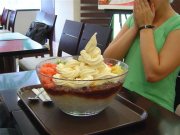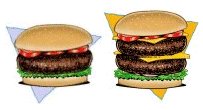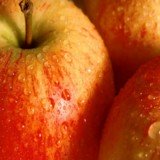Food Serving Size
Food Serving Size Introduction and History
In order to understand this subject, we first need to define it as well as the term food portion. These we're sure you've heard of and even used sometime but do we know the difference?
Food portion is the amount of food you as an individual choose to eat at any one point in time. When it comes to food portion size, no one portion can be said to be right or wrong. It's either just simply more or less than the recommended serving size depending on how much of it you eat.
The food serving size is what is used to provide nutritional information on foods and is designed to help one compare nutrition facts of similar foods. Put simply, a serving size is the standard amount of food that is used to advise you on how much to eat. That is, they are designed to assist you in determining how much to eat at meals so you do not en up over-indulging on some of your favorites! NB: Serving size is NOT necessarily the recommended amount of food to eat. Although you may find that sometimes it's smaller or larger than or is the same as the recommended serving size.
 One of the biggest challenges that most people face today when it comes to meal and or snack times is portion control. Generally speaking, food portions and serving sizes have been on the increase over the past 20 years. This has not only been in the fast food outlets but also in our homes at our dinner tables.
One of the biggest challenges that most people face today when it comes to meal and or snack times is portion control. Generally speaking, food portions and serving sizes have been on the increase over the past 20 years. This has not only been in the fast food outlets but also in our homes at our dinner tables.
It's important, as with most of the other things in life (too much of anything is not good!) to moderate your food intake and have a well-balanced diet. Moderation is one of the keys to eating healthy. The increase in food portions has had a negative health effect on a lot of people of this generation across the globe, especially in America. The proof is on the waistlines.
The National Institutes of Health produced a report showing that 1 in 4 Americans are obese. Obesity, more so childhood obesity has also been on the rise worldwide. It comes with many adverse health effects such as diabetes, heart diseases and arthritis, just to name a few. few. Therefore it is of utmost importance to portion your food serving size correctly as well as get plenty of physical activity (and we're not only talking about the routine or typical exercises, even housework or washing the car is physical activity) in order to lead a healthy lifestyle. As we've just mentioned earlier, food portions and ultimately one's food serving size has generally been on the increase over the years.
According to the Journal Of American Medical Association the following facts have been deduced: 20 years ago
- Soda pops also referred to as soft drinks have increased in size by 52%.
- A bagel has increased in calories from 140 to 350 calories.
- Hamburgers have become nearly 25% if not 50% larger.
- A typical cheesecake slice had 260 calories, today it has 640 calories.
- A standard cup of coffee had 85 calories, today, because of the added sugars and whole milk and cream as well as the size, it has about 350 calories.
- A portion of spaghetti and sauce with 3 meatballs would have been about 500 calories, today it's 1,025 calories.
- A standard blueberry muffin had 310 calories less as compared to the ones served these days.
- Calories in french fries have increased from 210 to about 610. It would take you about 1 hour 10 minutes to burn those extra 400 calories!
- A turkey sandwich used to come with 320 calories. Today it's a whooping 820 calories. You would have to cycle for about 1 hour 25 minutes to burn those extra 500 calories.
- A chicken Caesar salad had about 390 calories, compared to today's 790 calories.
- A typical bag of snack food, whether it is potato chips, pretzels or crackers used to be 60% less than it is now.
 As you can see, food portions have been on a rise and frankly speaking it's quite shocking how much we are consuming these days at just one sitting or the whole day's worth of food. In fact, with the way things are going it is set to even increase further if no controls are put. You will realize that in all this, most of the food is not as healthy, it's mostly refined, deep-fried and salty foods. Not that you cannot consume these, you may, but once in a while not everyday. One of the things that were created in order to help individuals with eating healthy is the food pyramid diagram (which seems to be slowly replaced by the eat well plate or My Plate). Both serve to do the same thing, that is aid you to have a rough idea of how much from each food group you're supposed to have in a day. We will briefly take a look at both.
The Eat Well plate calls for:
As you can see, food portions have been on a rise and frankly speaking it's quite shocking how much we are consuming these days at just one sitting or the whole day's worth of food. In fact, with the way things are going it is set to even increase further if no controls are put. You will realize that in all this, most of the food is not as healthy, it's mostly refined, deep-fried and salty foods. Not that you cannot consume these, you may, but once in a while not everyday. One of the things that were created in order to help individuals with eating healthy is the food pyramid diagram (which seems to be slowly replaced by the eat well plate or My Plate). Both serve to do the same thing, that is aid you to have a rough idea of how much from each food group you're supposed to have in a day. We will briefly take a look at both.
The Eat Well plate calls for:
- 40% carbohydrates, that is, bread, cereal, rice, potatoes, pasta and other starchy foods. Aim to eat whole grains where applicable.
- 40% fruits and vegetables,
- 8% milk and dairy products,
- 7% Meat, Fish, Eggs, Beans and other non-dairy sources of protein and finally
- 5% oils and sweets.
- Starches/ Carbohydrates: 6-11 servings (examples of a serving include 1 slice of bread, half a cup of rice, half a cup of pasta or half a bagel, etc)
- Vegetable Group: 3-5 servings (one serving could be 1 cup raw leafy vegetables or half a cup cooked vegetables, etc)
- Fruit Group: 2-4 servings (one serving from this group can be 1 whole medium fruit, half a cup fruit juice or quarter cup dried fruit, etc)
- Milk and Dairy Products Group: 2-3 servings (1 cup- 8fl oz/ milk or yogurt and 2 slices of cheese each count as a serving in this group)
- Meat and other non-dairy sources of protein group: 2-3 servings (examples of a serving include 2 eggs, 2oz/57g cooked lean meat, poultry or fish, 7oz/ 200g tofu, etc)
- Fats, Oils and Sweets: Use sparingly
The new food pyramid tweaked at this a little to suite different activity levels.
Food Serving Size GuideFor Children, Kids, Toddlers
The table below shows the suggested food serving size of food for children.
| Food Group | Number of Servings | 1-3 years | 4-5 years | 6-12 years |
| Carbs i.e Bread, Cereal, Pasta, Grains | 5 or less | half a slice or quarter of a cup | half a slice or a thrid of a cup | 1 slice or half a cup |
| Vegetables | 3-5 | a quarter of a cup | a third of a cup | half of a cup |
| Fruits | 2-4 | one quarter of a cup | one third of a cup | one half of a cup |
| Milk and Dairy Products | 2-3 | half a cup | three quarters of a cup | 1 cup |
| Protein, i.e Meat and other non-dairy sources of protein (nuts, eggs, tofu, beans, etc) | 2-3 | 1oz (28g) or a quarter of a cup | 1 1/2oz (43g) or a third of a cup | 2oz (56g) or half a cup |
In the carbohydrates group, where possible, aim to have whole grains as they are more nutritious. When it comes to vegetables, any vegetable or pure vegetable juice (100%) counts as a member of the vegetable group. You may have your vegetables in several ways to create variety, that is raw or cooked; fresh, frozen, canned, or dried/dehydrated; and may be whole, cut-up, or mashed. The same applies for the fruit group. In the milk and dairy products group, where possible, try to have Fat Free or 1% milk,yogurt and low sugar calcium fortified juices. Try to avoid the sweetened yogurts. And finally, the protein group, when eating meat, include more of the lean meats as they have less fat. The fats and sugars obviously have to be consumed sparingly. These same tips apply to teenagers and adults also whose table is just below.
Food Serving Size Guide For Teenagers and Adults
The table below shows the suggested serving sizes for teenagers and adults.
| Food Group | Number of Servings | 13 yrs and older |
| Carbs i.e Bread, Cereal, Pasta, Grains | 5 or less | 1 slice or half a cup |
| Vegetables | 3-5 | half a cup |
| Fruits | 2-4 | half a cup |
| Milk and other Dairy Products | 2-3 | 1 cup |
| Protein, i.e Meat and other non-dairy sources of protein (nuts, eggs, tofu, beans, etc) | 2-3 | 2-3oz (56-85g) or half a cup |
A short list of tips to get you started on the correct food serving size, in time you'll be a pro!
- A fist or cupped hand = 1 cup
- Your thumb tip = 1 teaspoon
- A handful = 1-2 oz (28-56g)of snack food
- 2-3 oz of Meat = A deck of cards or just the palm of your hand without the fingers
- Half a cup of Pasta/ rice, Vegetables, or a piece of fruit = a tennis ball
- 2 tablespoons peanut butter = Ping pong ball
- 1 oz (28g) cheese = 4 dice or your thumb
In conclusion, if you've realized that your food portions are too much you may want to try and make some changes, drastic ones if the portions you are having are way too much. You will obviously suffer some withdrawal symptoms after reducing your food portion and food serving size. It is very helpful to have some fruits and vegetables as snacks. It is advised to have 5 or more servings of fruits and vegetables a day. This way you will be snacking on highly nutritional food which is low in calories as well as reducing the risk of cancer. In fact, where possible make 50% of your plate fruits and vegetables. Most people's diets are seriously lacking in these.
Another trick would be to have high quality protein foods such as eggs, lean meat, nuts and poultry. Protein is an important part of any diet. It activates your metabolism and helps to you eat less by keeping you satiated for longer. One of the important things to have in mind is how much and how often to eat. Choosing healthy food, keeping your portions and food serving size in check and some physical activity will not only help you to lose weight but also maintain a healthy weight. You may also want to substitute refined foods for whole grains. For example white rice for brown rice, white bread for whole wheat or whole grain bread.


